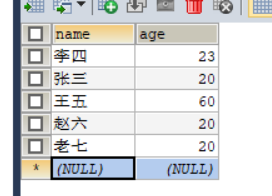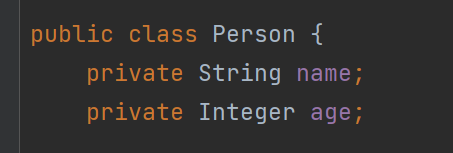六、MyBatis的各种查询功能
准备
数据库表
t_person表

实体类对象

1、查询一个实体类对象
通过name=“王五”进行查询一条数据,并封装在Person对象中。
mapper接口
public interface PersonMapper {
//通过name查询对象
Person selectPersonByName(@Param("name") String name);
}
映射文件
<mapper namespace="com.xxx.mapper.PersonMapper"><!--接口-->
<!-- Person selectPersonByName(@Param("name") String name);-->
<select id="selectPersonByName" resultType="com.xxx.pojo.Person">
select * from t_person where name=#{name}
</select>
</mapper>
测试
PersonMapper mapper = sqlSession.getMapper(PersonMapper.class);
Person zs = mapper.selectPersonByName("张三");
System.out.println(zs);
输出结果

2、查询一个list集合
查询所有age=20的人。
mapper接口
public interface PersonMapper {
//查询所有age=20的人
List<Person> selectPersonByAge(@Param("age") Integer age);
}
映射文件
<mapper namespace="com.xxx.mapper.PersonMapper"><!--接口-->
<!-- List<Person> SelectPersonByAge(@Param("age") Integer age);-->
<select id="selectPersonByAge" resultType="com.xxx.pojo.Person">
select * from t_person where age=20
</select>
</mapper>
测试
PersonMapper mapper = sqlSession.getMapper(PersonMapper.class);
List<Person> people = mapper.selectPersonByAge(20);
System.out.println(people);
输出结果

3、查询单个数据
查询年龄等于xx的人的个数。
mapper接口
public interface PersonMapper {
//查询年龄等于20的人的个数
Integer selectAgeCount(Integer age);
}
映射文件
<mapper namespace="com.xxx.mapper.PersonMapper"><!--接口-->
<!-- Integer selectAgeCount();-->
<select id="selectAgeCount" resultType="int">
select count(*) from t_person where age=#{age}
</select>
</mapper>
测试
PersonMapper mapper = sqlSession.getMapper(PersonMapper.class);
//查询年龄是20岁的人的个数
Integer integer = mapper.selectAgeCount(20);
System.out.println(integer);
输出结果

4、查询一条数据为map集合
根据用户name查询用户信息为map集合。
mapper接口
public interface PersonMapper {
//根据用户name查询用户信息为map集合
Map<String,Object> selectPersonByIdMap(@Param("name")String name);
}
映射文件
<mapper namespace="com.xxx.mapper.PersonMapper"><!--接口-->
<!-- Map<String,Object> selectPersonByIdMap(@Param("name")String name);-->
<select id="selectPersonByIdMap" resultType="Map">
select * from t_person where name=#{name}
</select>
</mapper>
测试
PersonMapper mapper = sqlSession.getMapper(PersonMapper.class);
//根据用户name查询用户信息为map集合
Map<String, Object> map = mapper.selectPersonByIdMap("王五");
System.out.println(map)
输出结果

5、查询多条数据为map集合
查询所有用户信息为map集合。
将表中的数据以map集合的方式查询,一条数据对应一个map;若有多条数据,就会产生多个map集合,此 时可以将这些map放在一个list集合中获取。
方式一:List
mapper接口
public interface PersonMapper {
//查询所有用户信息为map集合01。
List<Map<String,Object>> selectAllPerson01();
}
映射文件
<?xml version="1.0" encoding="UTF-8" ?>
<!DOCTYPE mapper
PUBLIC "-//mybatis.org//DTD Mapper 3.0//EN"
"http://mybatis.org/dtd/mybatis-3-mapper.dtd"><!--约束,约束不同xml中所写的标签也不同-->
<mapper namespace="com.xxx.mapper.PersonMapper"><!--接口-->
<!-- List<Map<String,Object>> selectAllPerson01();-->
<select id="selectAllPerson01" resultType="map">
select * from t_person
</select>
</mapper>
测试
PersonMapper mapper = sqlSession.getMapper(PersonMapper.class);
//查询所有用户信息为map集合01
List<Map<String, Object>> maps = mapper.selectAllPerson01();
System.out.println(maps);
输出结果

方式二:@MapKey注解
将表中的数据以map集合的方式查询,一条数据对应一个map;若有多条数据,就会产生多个map集合,并 且最终要以一个map的方式返回数据,此时需要通过@MapKey注解设置map集合的键,值是每条数据所对应的 map集合。
mapper接口
public interface PersonMapper {
//查询所有用户信息为map集合02。
@MapKey("name")
Map<String,Object> selectAllPerson02();
}
映射文件
<?xml version="1.0" encoding="UTF-8" ?>
<!DOCTYPE mapper
PUBLIC "-//mybatis.org//DTD Mapper 3.0//EN"
"http://mybatis.org/dtd/mybatis-3-mapper.dtd"><!--约束,约束不同xml中所写的标签也不同-->
<mapper namespace="com.xxx.mapper.PersonMapper"><!--接口-->
<!-- Map<String,Object> selectAllPerson02();-->
<select id="selectAllPerson02" resultType="map">
select * from t_person
</select>
</mapper>
测试
PersonMapper mapper = sqlSession.getMapper(PersonMapper.class);
//查询所有用户信息为map集合02
Map<String, Object> maps = mapper.selectAllPerson02();
System.out.println(maps);
输出结果
























 4045
4045











 被折叠的 条评论
为什么被折叠?
被折叠的 条评论
为什么被折叠?










